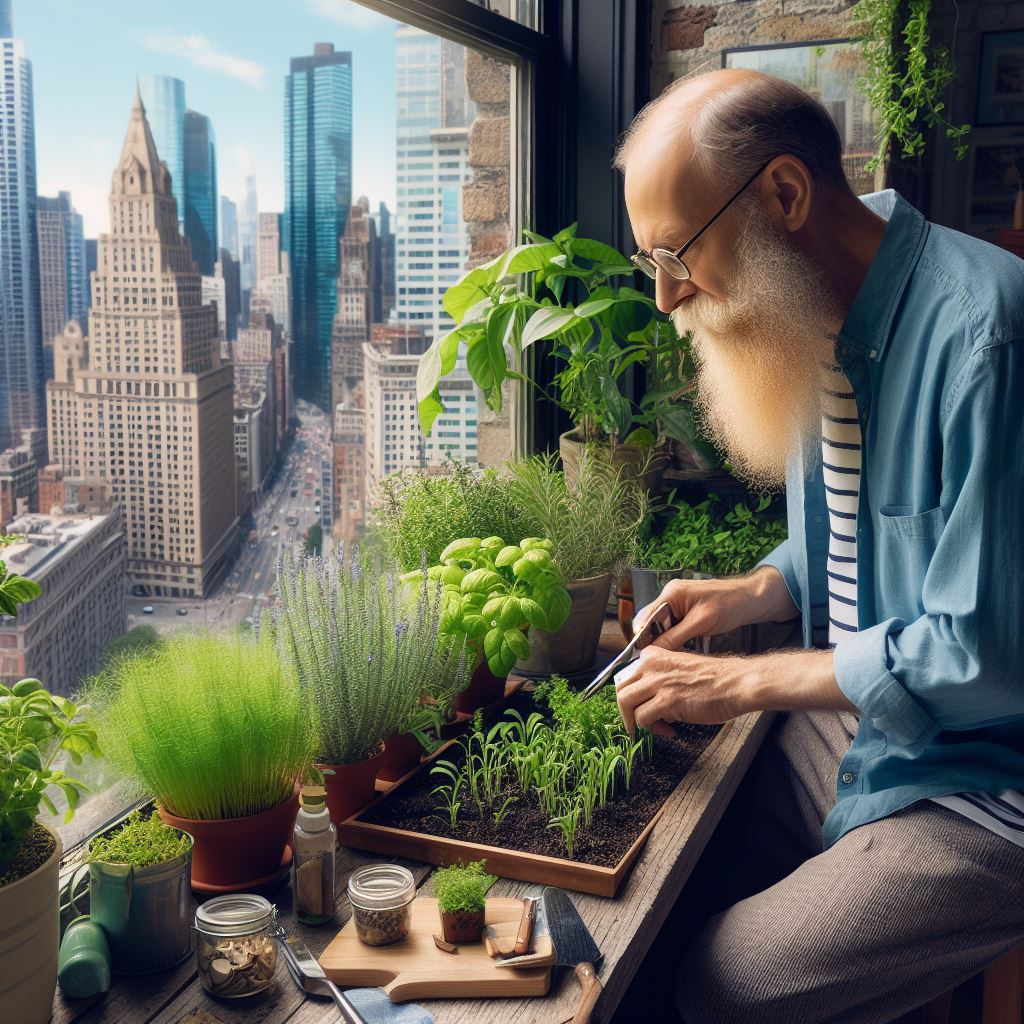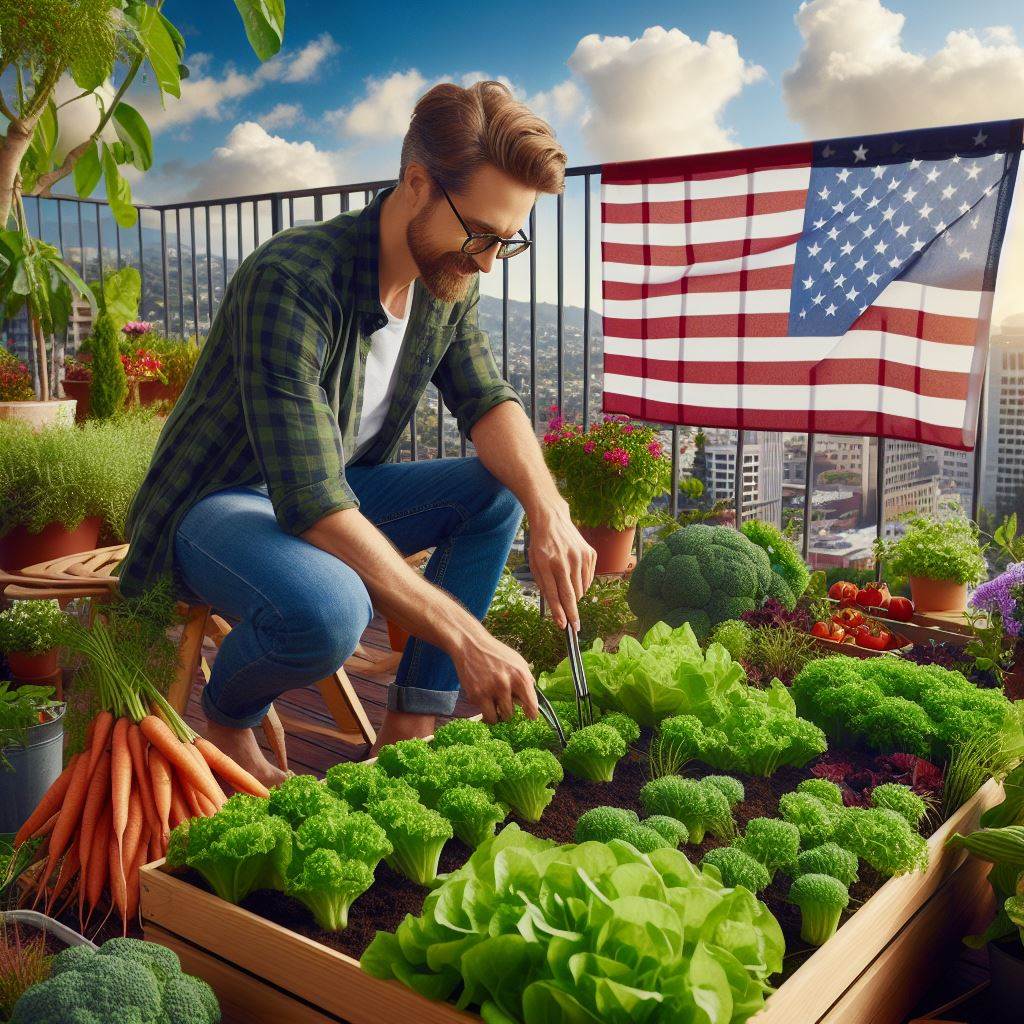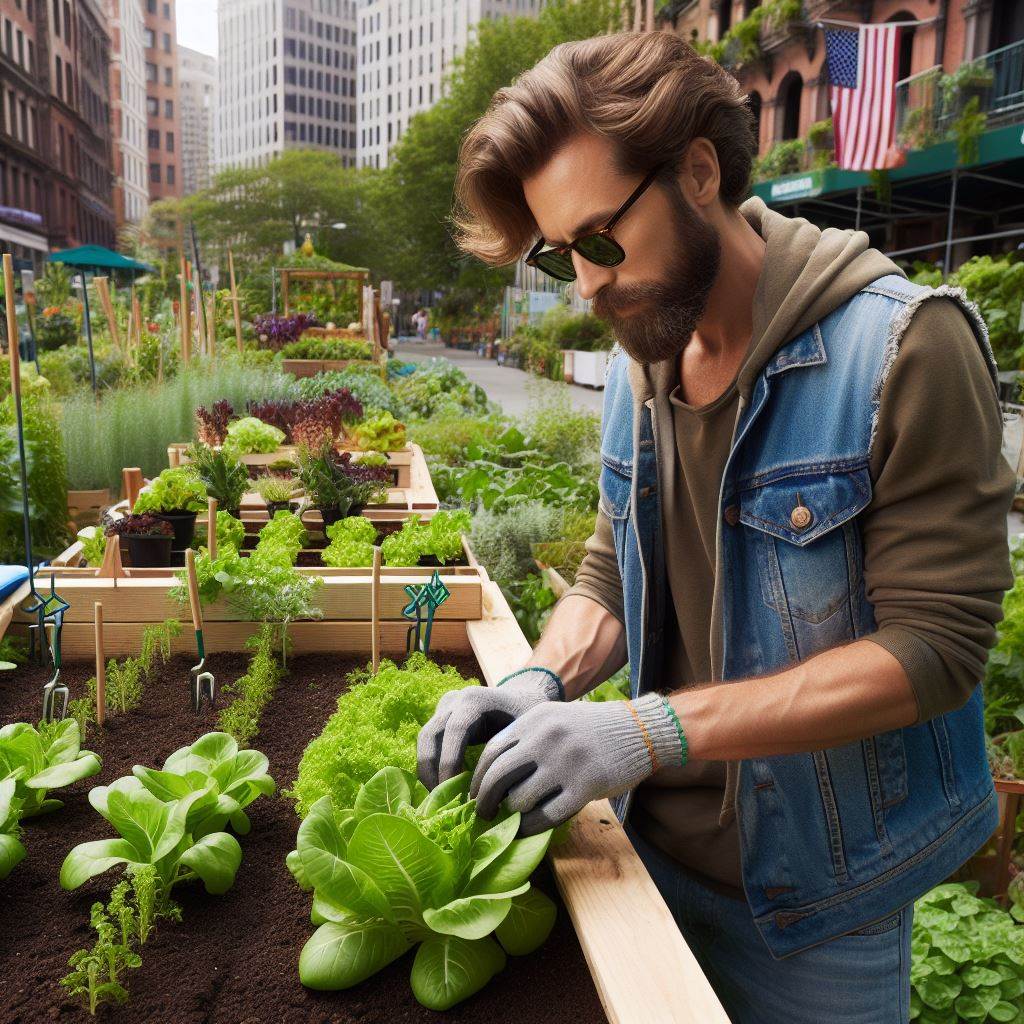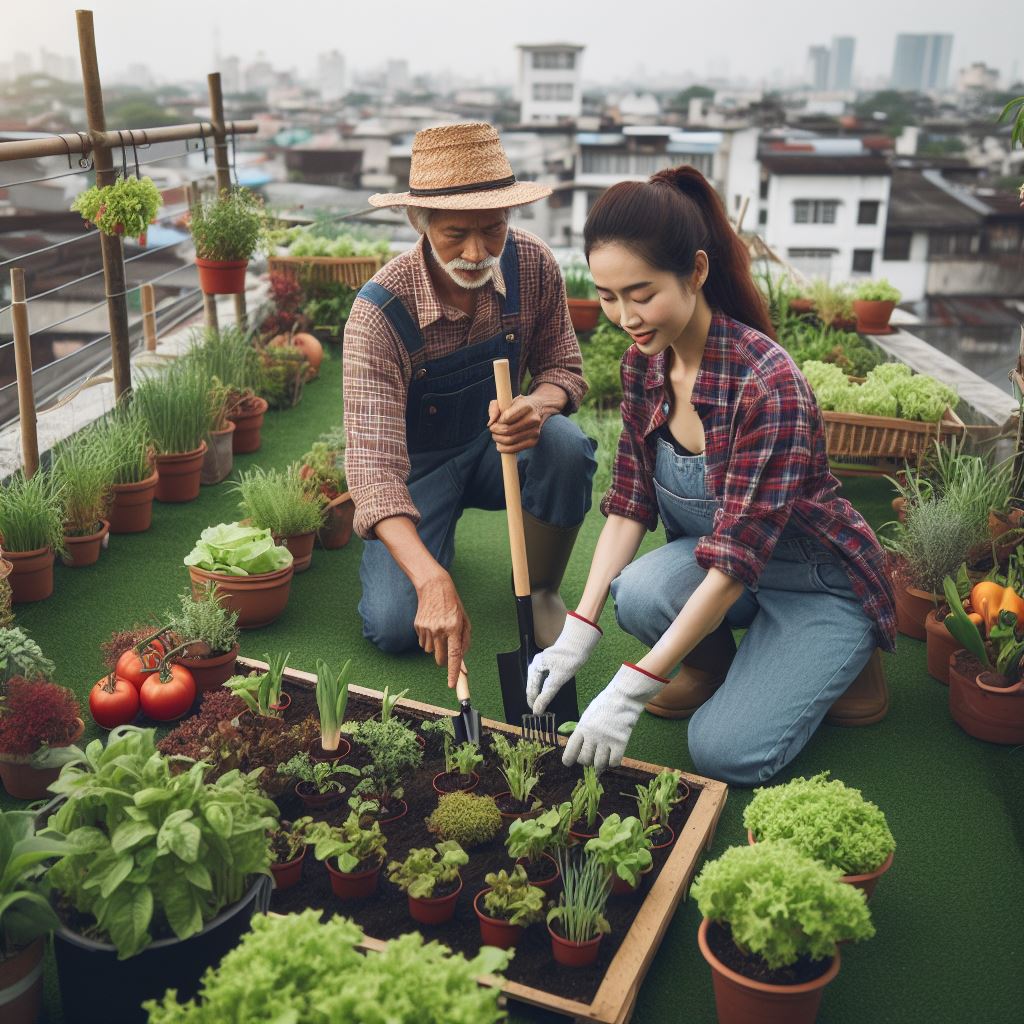Introduction
The concept of growing herbs in small spaces in urban areas
Growing herbs in small urban spaces is an innovative solution for the limited availability of land.
City herbs not only add flavor to our favorite dishes but also contribute to sustainable living.
In today’s urbanized world, space is a luxury.
People residing in cities often face the challenge of limited outdoor areas for gardening.
However, this constraint doesn’t have to stop us from enjoying the freshness and taste of homegrown herbs.
With some creativity and a little effort, it is possible to grow herbs in the tiniest of spaces.
Benefits and importance of city herbs for flavoring foods and promoting sustainable living
City herbs bring numerous benefits to urban dwellers.
By growing herbs in our balconies, rooftops, or even on a windowsill, we can effortlessly add incredible flavor to our culinary creations.
Freshly-plucked basil, mint, or rosemary can elevate the taste of any dish, turning a simple meal into a gastronomic delight.
But city herbs aren’t just about enhancing flavors. They play a crucial role in promoting sustainable living.
By opting for homegrown herbs, we reduce our reliance on store-bought alternatives that are often packaged in plastic and transported from afar.
Cultivating such herbs locally minimizes carbon emissions and helps in combating climate change.
Moreover, city herbs serve as green oases amidst the concrete jungles.
They beautify urban environments, purify the air, and even attract pollinators like bees and butterflies.
These tiny plants bring a touch of nature to our bustling cities, creating a sense of calm and tranquility.
Transform Your Agribusiness
Unlock your farm's potential with expert advice tailored to your needs. Get actionable steps that drive real results.
Get StartedBasically, growing herbs in small urban spaces is a practical and beneficial endeavor.
It allows us to enjoy the flavors of fresh herbs while embracing sustainable practices and creating a greener urban landscape.
So, let’s embrace city herbs and experience the joys of gardening, no matter how limited our space may be.
Choosing the Right Herbs
Types of herbs that are suitable for small spaces
When it comes to growing herbs in small spaces, there are a variety of options available.
Here are some types of herbs that are suitable for tiny gardens:
- Perennial herbs: These herbs come back year after year, making them a great choice for long-term growth in small spaces.
- Herbs that grow well in containers: Some herbs, such as thyme, basil, and parsley, thrive in pots and can be easily grown indoors or on balconies.
- Herbs that require minimal maintenance: If you’re looking for herbs that don’t require much attention, consider options like rosemary, oregano, and mint.
Tips on selecting herbs based on personal preferences and culinary uses
Now that we have discussed the types of herbs that are suitable for small spaces, let’s move on to selecting the right herbs based on personal preferences and culinary uses:
- Think about the flavors you enjoy: Do you prefer the strong taste of sage or the freshness of cilantro? Choose herbs that align with your personal preferences.
- Consider their culinary uses: Are you planning to use them in salads, soups, or as garnishes? Some herbs, like chives and dill, are perfect for enhancing the flavors of dishes.
- Take into account their growth habits: Some herbs, such as mint, can spread rapidly, while others, like thyme, stay compact. Choose herbs that suit the available space.
- Think about the space available: Do you have a sunny nook, a windowsill, or a vertical garden? Different herbs have different light requirements, so choose accordingly.
- Don’t forget about fragrance: Some herbs, like lavender and lemon balm, not only add flavor to dishes but also emit delightful aromas.
- Consider companion planting: Certain herbs, such as basil and parsley, can benefit from being planted together, as they help deter pests and promote growth.
Selecting the right herbs for your small space garden is crucial for successful growth.
Take your time, experiment, and enjoy the process of growing your own flavorful herbs!
Read: Watering Tips for Small Gardens & Farms
Selecting the Ideal Growing Containers
Importance of choosing appropriate containers for city herb gardening
Choosing appropriate containers for city herb gardening is crucial to ensure successful growth and flavor.
Different container options provide unique advantages and considerations for herb cultivation.
- Pots: Traditional pots are versatile and widely used for growing herbs in small spaces. They come in various sizes, materials, and styles.
- Window boxes: These long, narrow containers are perfect for mounting on windowsills and railings, maximizing vertical space.
- Hanging baskets: Ideal for suspending herbs, hanging baskets save space and add aesthetic appeal to balconies and patios.
- Vertical planters: These innovative structures allow herbs to grow vertically, maximizing space and creating green walls of flavor in urban environments.
Various container options
When selecting containers for urban herb gardening, keep the following tips in mind:
- Consider available space: Assess the area where you plan to grow herbs, ensuring the containers fit without overcrowding.
- Match container size to herb requirements: Different herbs have varying root depths, so select containers accordingly.
- Ensure proper drainage: Containers must have drainage holes to prevent waterlogged soil, which can lead to root rot.
- Choose suitable soil: Use a well-draining potting mix specifically formulated for container gardening to provide the necessary nutrients.
- Consider self-watering containers: These containers have built-in reservoirs that help maintain consistent moisture levels and reduce watering frequency.
- Use saucers or trays: Placing containers on saucers or trays helps catch excess water, preventing damage to indoor surfaces or outdoor spaces.
Importance of proper drainage and suitable soil for container herb gardening
Proper drainage and suitable soil are fundamental elements for successful container herb gardening:
Good drainage ensures that excess water flows out of the containers, preventing waterlogged soil.
Without proper drainage, roots may suffocate and lead to plant decline or death.
Choosing a well-draining potting mix is vital because it allows air to reach the roots, preventing them from becoming waterlogged.
Good soil also provides the necessary nutrients for healthy growth.
Additionally, containers with adequate drainage help prevent the accumulation of harmful salts in the soil, which can negatively impact herb growth and flavor.
Remember, the choice of containers for city herb gardening is not just about functionality.
Aesthetics can also play a role in creating an appealing urban oasis.
Consider the overall design and style when selecting containers to enhance the visual appeal of your herb garden.
Read: Seasonal Planting Strategies for Hobbyists
Creating a Suitable Growing Environment
Importance of sunlight for herb growth
Sunlight plays a crucial role in the growth and development of herbs.
It is essential for photosynthesis, the process by which plants convert light energy into chemical energy.
Showcase Your Farming Business
Publish your professional farming services profile on our blog for a one-time fee of $200 and reach a dedicated audience of farmers and agribusiness owners.
Publish Your ProfileThe energy produced during photosynthesis is used for various metabolic activities, including growth, flowering, and the production of essential oils.
Without sufficient sunlight, herbs may become weak, leggy, and fail to thrive.
Optimal amount of sunlight required for different herbs
Different herbs have varying sunlight requirements.
While most herbs prefer full sun, which means at least six hours of direct sunlight per day, some can tolerate partial shade.
For instance, basil, thyme, and oregano thrive in full sun, while parsley, cilantro, and mint can tolerate some shade.
Understanding the specific sunlight needs of each herb is crucial for successful cultivation.
Techniques for maximizing sunlight exposure in tiny spaces
In limited space, maximizing sunlight exposure can be challenging.
However, there are several techniques to overcome this constraint:
- Choose the right location: Place your herbs near a south-facing window or the brightest spot in your indoor space to ensure maximum sunlight exposure.
- Reflective surfaces: Utilize reflective surfaces, such as mirrors or white walls, to bounce light and increase its distribution within the space.
- Rotate your herbs: Regularly rotate your herbs to ensure all sides receive equal sunlight and prevent them from leaning or stretching towards the light source.
- Artificial lighting: If natural sunlight is limited, consider using artificial grow lights, such as fluorescent or LED bulbs, to supplement the light needs of your herbs.
Significance of air circulation and humidity for herb growth
Air circulation and humidity are crucial factors that affect herb growth and overall health.
Adequate air circulation helps prevent the development of fungal diseases by reducing the moisture around the plant leaves.
It also strengthens the plants’ stems and promotes transpiration, the process of water movement through the plant, which aids in nutrient uptake.
Humidity levels are particularly important for herbs originating from tropical regions.
Mimicking their native environment by increasing humidity can enhance their growth.
However, excessive humidity can lead to fungal growth, so maintaining a balance is vital.
Tips on maintaining an ideal growing environment
To maintain an ideal growing environment for herbs:
- Ventilation: Proper air circulation can be achieved by placing a small fan near your herbs or by opening windows periodically. This helps prevent stagnant air and reduces the risk of disease.
- Watering techniques: Water your herbs properly by providing enough moisture without overwatering. Ensure the soil is moist but not saturated, and allow the top layer to dry before watering again. Always aim for the roots rather than the leaves to prevent fungal issues.
- Use well-draining soil: Herbs prefer a well-draining soil mix that allows excess water to escape. This prevents waterlogged roots, which can lead to root rot and other diseases.
- Keep an eye on humidity: Monitor the humidity levels in your growing area and adjust as necessary. Provide humidity trays or mist the leaves occasionally to increase humidity for tropical herbs.
Creating a suitable growing environment for city herbs requires careful consideration of sunlight exposure, air circulation, and humidity levels.
By implementing these techniques, you can maximize the growth and flavor potential of your herbs even in tiny spaces.
Read: Composting: A Guide for Urban Farmers

Care and Maintenance
Basics of caring for city herbs
- Understanding the basics of caring for city herbs is essential for a successful urban garden.
- Regular watering is crucial to maintain the health and vitality of herbs in small spaces.
- Fertilizing plays a significant role in providing essential nutrients to support herb growth.
- Pruning helps control the size and shape of herbs while promoting bushier and more robust growth.
Tips for Dealing with Common Issues
- In small urban gardens, pests and diseases can become a challenge to herb growth.
- Inspect your herbs regularly and identify any signs of pests or diseases.
- Consider using organic pest control methods to minimize harm to the environment and your health.
- Introduce beneficial insects and birds to your garden to naturally eliminate pests.
- Encourage biodiversity by planting companion plants that repel common herb pests.
- Avoid overwatering, as it can create damp conditions that attract pests and fungal diseases.
- Closely monitor the moisture levels of the soil and adjust watering accordingly.
- Promote good air circulation around your herbs by spacing them adequately and trimming back dense growth.
- Practice good garden hygiene by removing dead or diseased herb leaves and regularly cleaning the garden area.
Benefits of Organic and Natural Pest Control Methods
- Using organic and natural pest control methods ensures the safety of your herbs for culinary purposes.
- These methods are environmentally friendly, preserving the balance of urban ecosystems.
- Organic pest control methods do not harm beneficial insects, bees, or other pollinators.
- Chemical-free pest control promotes a healthier garden and reduces the risk of chemical residues on herbs.
- Natural methods, such as companion planting and insect-repelling herbs, encourage a natural pest control system.
- Choosing natural pest control methods minimizes the risk of pesticide toxicity for you and your family.
Read: Balcony Gardens: Growing in Small Spaces
Harvesting and Using City Herbs
Best time for harvesting herbs
In order to maximize flavor, it’s important to harvest herbs at the right time.
- Choose a sunny morning to harvest herbs, before the heat of the day intensifies.
- For leafy herbs such as basil and mint, harvest when they are at their peak, just before flowering.
- For woody herbs like rosemary and thyme, harvest in the morning when the oils are the strongest.
Different harvesting techniques
When it comes to harvesting techniques, there are a few different methods to consider.
- For leafy herbs, use scissors or a sharp knife to cut the stems just above a leaf node to encourage bushier growth.
- For woody herbs, use pruning shears to snip off the top third of the stem, leaving enough leaves to sustain growth.
- Harvest herbs regularly to keep them from becoming overgrown and to ensure a steady supply.
Ways to preserve and store harvested herbs
Preserving and storing harvested herbs properly will allow you to enjoy their flavor all year round.
- Drying herbs is the most common preservation method. Tie small bundles of herbs together and hang them upside down in a well-ventilated area.
- Alternatively, you can place herbs on trays and dry them in a low oven or use a dehydrator.
- Once herbs are dry, store them in airtight containers away from heat and sunlight to maintain their flavor.
Creative ideas for using city herbs
City herbs can be used in a multitude of creative ways, adding unique flavors to various applications.
- In cooking, use fresh herbs to enhance the flavors of salads, soups, stews, and marinades.
- Brew your own herbal teas by steeping fresh or dried herbs in hot water for a soothing and aromatic beverage.
- Create homemade beauty products such as herb-infused oils for massages or add dried herbs to bath salts.
The convenience of having fresh herbs at hand in a city setting cannot be overstated.
Not only is it a cost-saving measure, but it also eliminates the need to make last-minute trips to the grocery store.
By growing herbs in tiny spaces, you have access to an abundance of flavors right outside your door.
Conclusion
Throughout this blog post, we have discussed the benefits and techniques of growing city herbs in small spaces.
By summarizing the key points, reinforcing the benefits, and encouraging readers to start their own herb gardens, we hope to inspire experimentation with different herbs and flavors.
We must not forget the positive impact that small-scale urban gardening can have on sustainability and wellbeing.
Growing herbs in tiny spaces not only adds flavor to our dishes but also helps reduce carbon footprint, improve air quality, and promote mental and physical wellness.
So, why not take the first step towards creating your own urban herb garden?
Whether you have a balcony, a small yard, or even just a windowsill, starting your own herb garden is an accessible and rewarding endeavor.
Play around with different herbs and flavors, experiment with recipes, and discover the joy of fresh, homegrown herbs just at your fingertips.
Embrace the versatility of city herbs and amp up the flavor in your meals like never before.
There’s no better time than now to start your own tiny urban garden and enjoy the endless benefits it brings.




